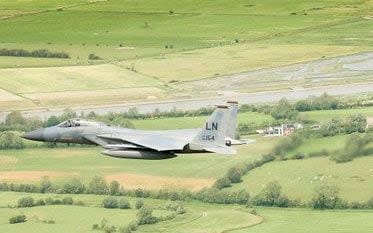Body of pilot found after US Air Force F-15C fighter jet crash off coast of England

The pilot of the US Air Force F-15C fighter jet that crashed off the north-east coast of England has been found dead, RAF Lakenheath have confirmed.
This evening Col Will Marshall, comandander of the 48th fighter wing at Suffolk’s RAF Lakenheath where the aircraft was based, said the pilot of the downed F-15C Eagle had been “located and confirmed deceased”.
He added that the pilot’s name would not “be released until all next of kin notifications have been made”.
“This is a tragic loss for the 48th Fighter Wing community, and our deepest condolences go out to the pilot’s family and the 493rd Fighter Squadron,” he said.
He said that the cause of the crash at around 9.40am today was “unknown at this time”.
The Daily Telegraph understands that the US fighter jets were engaged in air intercept training with two planes acting as the "enemy" when the aircraft crashed.
Her Majesty's Coastguard, who responded to the incident, confirmed that it had also located and started the recovery of the wreckage.
Ben Wallace, the Defence Secretary, tweeted: "Our thoughts are with our friends US Air Force and all those at RAF Lakenheath at this time." He said the Ministry of Defence stood ready to support allies at the US Embassy.
The single seater fighter jet was 74 nautical miles off the coast at Flamborough Head when it went down.
It is understood that it was part of a routine sortie that was likely performing two jets against two, with one pair simulating the enemy.
US Air Force officials were unable to say if they had indication that the pilot had managed to eject, however it is understood that a Personal Locator Beacon (PLB), which are worn by all pilots in order to send an emergency signal in case of an accident, was not transmitted.
If a pilot had ejected from an aircraft the PLB would have transmitted automatically, unless it was broken, although aircraft experts said it was unlikely as they are used to operating under huge stress.
The pilot of the downed F-15C Eagle from the 48th Fighter Wing has been located, and confirmed deceased.
This is a tragic loss for the 48th Fighter Wing community, and our deepest condolences go out to the pilot's family and the 493rd Fighter Squadron.https://t.co/GwCWFwImaS— RAF Lakenheath (@48FighterWing) June 15, 2020
Earlier that morning as the jets set off for the exercise RAF Lakenheath tweeted an image of F-15C Eagles with the caption “ready to take on Monday like…”, however a spokesman for the base confirmed that the image had been taken on a different day and was not from Monday morning.
Andrew Brooks, Director of the Air League, the aviation and aerospace charity, warned fighter pilots trained “realistically” and as a result were at risk of crashes.
“In order to train properly you have to fly to the limits,” he told The Telegraph.
“You train really low, where the enemy would be coming in from beneath the radar, practising really low, fast and frenetically. If there was mist over the North Sea that might impair visual references and cause visual misjudgement where the horizon disappears. You can literally fly into the sea, particularly if you are straining, pulling lots of g-force, really working hard, you can do that.”
Ready to take on Monday like...#WeAreLiberty! #ReadyAF pic.twitter.com/QrwCrHp5bv
— RAF Lakenheath (@48FighterWing) June 15, 2020
When G force is increased, it means blood from the head is pulled down to the lower part of the body and can cause visual impairment, and sometimes loss of consciousness.
While the cause of the crash has yet to be established an RAF source cautioned that “most incidents relating to crashes are human error”, while a bird having been sucked into an engine was also suggested as a possibility.
A Met Office spokesman confirmed that "fog patches" had been forecast for the entire Humber shipping area at the time of the crash.
He added that a ship around 40 miles offshore had also reported an exceptionally low cloud base of just 200m above the water, potentially hampering visibility for pilots.
The F15C, a model that has been used by the US Air Force since 1979, are said to have an "exceptional flight safety record".
At a glance: RAF Lakenheath
RAF Lakenheath is the "largest US Air Force-operated base in England and the only US air forces in Europe F15 fighter wing", its website said.
The 48th Fighter Wing, which has operated from the base since 1960, has more than 4,500 "active-duty military members".
Its mission statement is to "provide worldwide responsive combat air power and support".
In October 2014, an F15D fighter jet based at RAF Lakenheath crashed in fields near Spalding in Lincolnshire.
The pilot ejected safely, suffering only minor injuries, and no-one on the ground was hurt.
A US Air Force investigation found that the crash was caused by the "angle of attack" of the aircraft and "imperfections" in the assembly of the jet's nose cap.
In October 2015, US pilot Major Taj Sareen died when his F-18 Hornet jet crashed on farmland near RAF Lakenheath.
A subsequent investigation found the 34-year-old did not report problems with his aircraft before take-off.

 Yahoo News
Yahoo News 